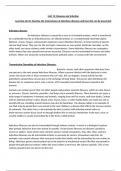Unit 12: Diseases and Infection
Learning Aim B: Examine the transmission of infectious diseases and how this can be prevented
Infectious disease:
An infectious sickness is caused by a virus or its harmful product, which is transferred
to a vulnerable host by an infected person, an infected animal, or a contaminated inanimate object.
Bacteria, viruses, fungus, and parasitic organisms cause infectious illnesses. A broad variety of species
call our body home. They are, for the most part, innocuous or even useful. Particular microbes, on the
other hand, can cause sickness under certain circumstances. Some infectious illnesses are contagious,
which means they may spread from person to person. Diseases can be transmitted by insects and other
animals. Others are spread by contaminated food, polluted water, or contact with the environment.
Transmission/Spreading of Infectious Diseases:
Bacteria, viruses, and other organisms that pass from
one person to the next spread infectious illnesses. When a person infected with the bacteria or virus
comes into touch with or kisses someone who isn't sick, this can happen. Sexual activity has the
potential to spread these viruses due to the exchange of body fluids. The person who distributes the
disease has no symptoms and is only a carrier. STDs (sexually transmitted diseases) spread in this
manner.
Animals can contain germs that can infect people and produce zoonotic illnesses, which are also known
as zoonoses. Viruses, bacteria, parasites, and fungi cause zoonotic illnesses. These bacteria can cause a
wide range of symptoms in humans and animals, ranging from mild to severe, and even death. Contact
with an infected animal's saliva, blood, urine, mucus, feces, or other bodily fluids can make you sick or
possibly kill you. Handling animal manure may also be hazardous. The disease rabies is an example of
one that may be spread from one animal to the next. Rabies is a disease that affects the nervous system
of mammals. The rabies virus is disseminated by direct contact with infected animal saliva or
brain/nervous system tissue (such as through broken skin or mucous membranes in the eyes, nose, or
mouth). Rabies is usually transmitted by a bite from a rabid animal.
Infectious illnesses can also be transmitted through indirect contact. A vector is a biological creature
that spreads infections from one animal to another. Vector-borne illnesses are diseases carried by
insects or spiders. Some of the most common vectors include mosquitoes, ticks, flies, fleas, and lice.
Infectious illnesses can be transmitted actively or passively by vectors: Mosquitoes and ticks, for
example, may contain diseases that may grow inside their bodies and be transmitted to new victims by
biting. Infectious germs may be picked up on the exterior of mechanical vectors like flies and spread to
people through physical contact. When the insect strikes a new host, the sickness spreads. This is how
malaria spreads from one person to the next.




